1. Photosynthesis
2. Where does photosynthesis take place - tree pipe system
3. The opposite of photosynthesis - respiration
4. Does a plant need more than water, sunlight and carbon
dioxide to grow?
5. Carbon atom cycle
6. Tasks
Photosynthesis
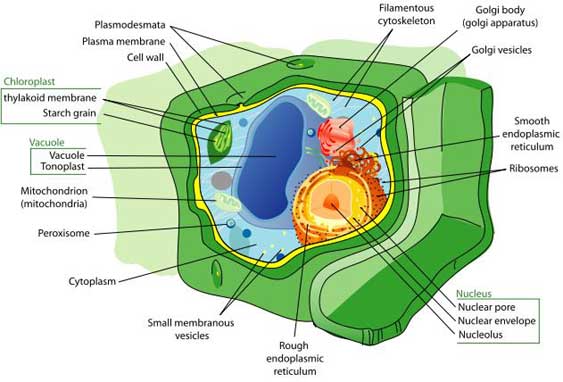
Above is shown a plant cell. A plant cell contains
chloroplasts with chlorophyll.
The green chlorophyll helps the photosynthesis reaction to
occur. (Info about picture)
Land plants absorb carbon dioxide (gas) from the air and
water plants take up carbon dioxide (gas) dissolved in
water. In exchange land and water plants emit oxygen. The
chemical reaction describing the reaction is called the
photosynthesis reaction:
Carbon dioxide + water + energy  glucose + oxygen
glucose + oxygen
6CO2 + 6H2O + energy (sunlight)  6O2 + C6H12O6
6O2 + C6H12O6
Apparently, the plant needs carbon dioxide, water and
sunlight (energy) to produce oxygen. Simultaneously glucose
is formed. Glucose is needed to build the tree or plant. The
glucose builds up leafs, stems but also the fruits of the
plant.
Trees / plants / bushes that grow can connect glucose
molecules into starch or cellulose.
A plant can use glucose to form starch (potato, wheat, root
vegetables). Here are about 300-400 glucose molecules linked
together in a row as strings. The strings in starch form
spirals.
Glucose molecules linked together as straight strings can
form long fibers. The number of glucose molecules linked
together can be about 1000-1200 pieces. Cellulose builds up
i.e. the stem and leaves of a tree.
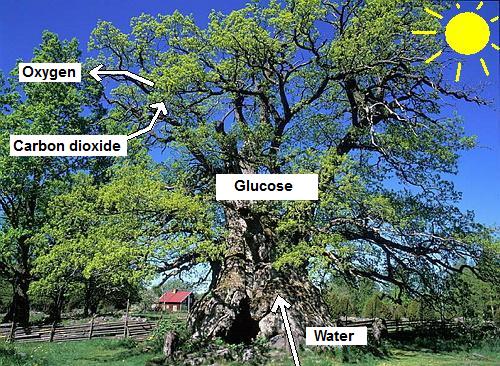
Where does photosynthesis take place - tree
pipe system
Photosynthesis occurs in plant leaves. The cells in the
leaves have small units called chloroplasts. Chloroplasts
contain chlorophyll. Chlorophyll is a green dye with the
task to facilitate the photosynthesis reaction. Therefore,
the photosynthesis occurs in the green chloroplasts. Carbon
dioxide enters the leaves through tiny openings on the
underside of the leaves. These openings are called stomata
(see photo to the left). In comes carbon dioxide and out
comes oxygen. Out comes also excessive water that the plant
has taken up from the soil through its roots. A large birch
needs several hundred liters of water a hot summer day.
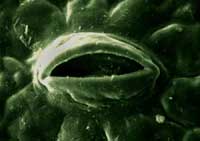
These stomata are magnified 350 times. (Info about picture)
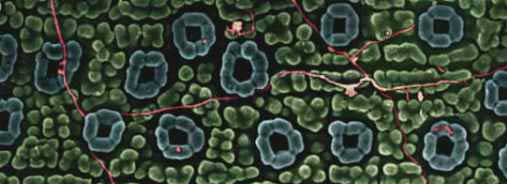
To provide the entire tree with sugar manufactured during
photosynthesis the tree has a pipe system. The sugar
produced in the leaves passes down through the bark to the
roots. This way also the roots can grow.
To provide the tree with water for the photosynthesis, water
is sucked up through the roots. The water is led inside the
tree trunk up to the tree's crown. The water is transported
to the leaves.
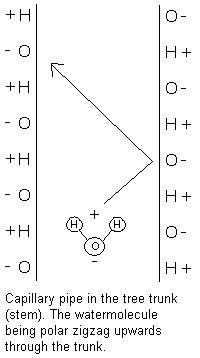
The reason that water travels up through the tree depends on
two things. Partly because the water travels up through
narrow pipes in the tree - the water is drawn up by
something called capillary attraction (see photo to the
left). Each water molecule is polar. This means that each
water molecule has a positively charged side and a
negatively charged side. The pipe wall in the tree pulls
either the positively charged side of the water molecule or
the negatively charged side. Water contains oxygen and
hydrogen (H2O). Also the capillary water traveling contains
hydrogen (H) and oxygen (O). The water is thus drawn up
through the tree.
The second reason why water is pulled up to the tree's crown
is that when the sun warms the tree, water evaporates. The
water leaves the tree through the tree's stomata. As this
happens a negative pressure is formed in the pipes carrying
water to the tree crown. This vacuum sucks up water just
like when you suck up the juice through a straw.
The opposite of photosynthesis -
respiration
The trees create oxygen that humans and animals need. We
humans use oxygen and glucose. Oxygen and glucose react to
form water, carbon dioxide and energy. It is the very energy
that we humans need. We thus extract energy that once was
stored in plants through photosynthesis. The reaction looks
as follows and is called the cellular respiration reaction:
Oxygen + glucose  carbon dioxide + water +
energy
carbon dioxide + water +
energy
6O2 + C6H12O6  6CO2 + 6H2O + energy
6CO2 + 6H2O + energy
If we instead burn wood then carbon dioxide, water and
energy are created and released. This happens also according
to the reaction foresaid above. But there is a difference,
this combustion reaction can take place only after the
ignition temperature of wood is reached. This temperature is
about 300 oC. The Cell respiration reaction in humans occurs
at only 37 oC. This is because the body has substances that
lowers the activation energy from 300 oC to only 37 oC. The
cellular respiration reaction is controlled by the body.
Does a plant need more than water,
sunlight and carbon
dioxide to grow?
The answer is yes. The plant also needs certain nutrients
absorbed by the soil water. These nutrients can be phosphate
and nitrate. Also some ions are can be helpful. I.e. sodium
ions (Na+), calcium ions (Ca2+), potassium ions (K+) and
magnesium ions (Mg2+). Chemical fertilizers used by farmers
on farmland contain primarily nitrogen (N), phosphorus (P)
and potassium (K).
Carbon atom cycle
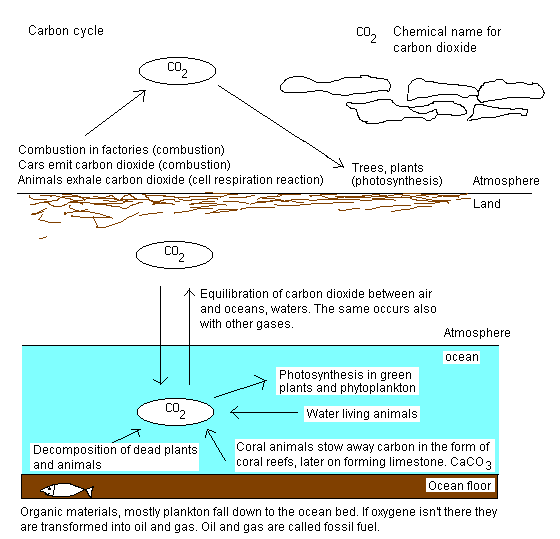
Animals and plants eaten by animals are transformed through
the cellular respiration reaction to carbon dioxide, water
and energy.
Tasks:
1. Draw a leaf and show with arrows what is needed and what
is emitted when photosynthesis occurs?
2. Tell about the cellular respiration reaction?
3. If you are to grow aquarium plants - what does the water
need to contain to let the plants grow extra well?
4. Think of a leaf as a factory. What are the raw materials,
products, and machinery?
Copywrite NGU, Northern Pontifical Academy 2025 (A.I.C.)